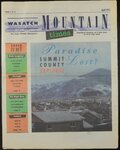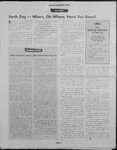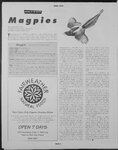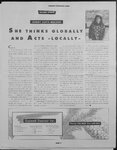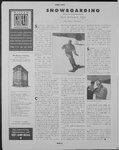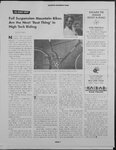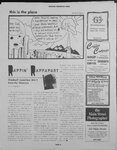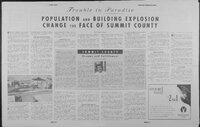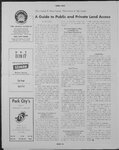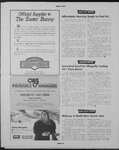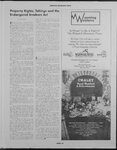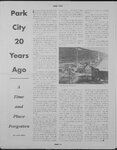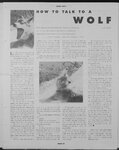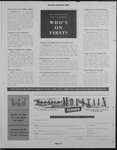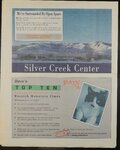| OCR Text |
Show APRIL For a Good Time “Sleigh Ride Dinners in ~ se City, Cal 1995 Snowmobiling ~ Hot-Alr Bali \ a Wo Car Rentals wg) K fg v Fishing Trips ~ Gambling Tours ~Y Lodgi Lodging Reservations CS “ao - The Adventure Center oneatack ¢% Rides Helicopter Skiing Snowcat Skiing ~ Concert Tickets Utah’s Wilderness Ignores Wild Ecosystems @ Receive FREE information and reservations on activities, lodging and transportation. © Enjoy premiu By Dick Carter cougar, black bear and other sensitive species require very real wilderness to survive, but they don’t recognize man-made wilderness boundaries. Research efforts by conservation biologists consistently show that few, if any, undeveloped regions, national parks, or wildernesses, designated or not, can provide habitat for the long-term survival of native fauna. In part, this decline in biodiversity is because we have surrounded our wildernesses by intensively managed multiple use lands and continue to “objectify” wilderness as simply another resource for human use. More than any other resource, wilderness has defined our land ethic and our personal, humane and spiritual values toward land and its life. Wilderness forces a core change quality and the best p ® Avoid guesswork-we only book with Park City’s most respected companies ASK HOW YOU CAN ENJOY MANY OF OUR ACTIVITIES FOR FREE! ABC Reservations Central (801)-649-ABCD (2223) Visit our Information Center at 514 Main St., Park City Utah Uwe Le ae a fal > Learn from a Pro Janet Dart has been training individuals and businesses on IBM compatible computers since 1982. Winter Group Classes: * Introduction to Windows ¢ Beginning WordPerfect ¢ Word for Windows ¢ Advanced WordPerfect, DOS 5.1 ¢ Upgrading to WordPerfect 6.0 On Site Training: We will customize a training program to fit your needs at your home or business. Call Us at 801-645-8563 Subscribe! Call or fax 801-649-8046 a Debate Dick Carter, director Wilderness Association he debate over BLM wilderness in Utah triggers inordinate emotion. Among many complex reasons for this, is that it is ae unmatched. It has been carved| wind and rain, lifted, dropped, ni scorched, and has formed canyons and cliffs, bridges and arches, fins, buttes and mesas stained in red, buff, yellow and purple — that all change with the rising, setting, and seasonal angle of the sun. It is also massive and undeniably wild. But it does not match the traditional view of wilderness. Our in thing image European. the 1976 Land Management Act, passage Policy this of the and image Some have tried to argue from was improved upon. The BLM wilderness review began in the late 1970s, followed by a massive victorious appeal by the Utah Wilderness Association, that ultimately resulted in 3.2 million acres of wilderness study areas with 2 million acres being recommended as suitable for wilderness designation. that wilderness is nothing but an abstract construct, which benefits only the elite. But as our perceptions of the natural world have matured, it is becoming increasingly clear that wilderness — wildness — if it is to survive, is not for us. Wilderness has inherent or metaphysical value. If we prove unable to recognize this, then wilderness will be transformed into another human-defined “resource,” another object assured of exploitation and eventual loss of wildness. BLM wilderness, for example, should be for bighorn sheep, not hunting bighorn sheep. This raises another dilemma: Bighorn sheep, perceptions A wilderness else. — a new para- isn’t for some- It is moment to moment. Thunder to lightning. Warm sun to cool breeze. Its value isn’t a use like real estate, but the process of existence. The Wilderness Act contemplated wilderness as a place — “a place of wild beasts” — and a process — “wilderness.” In two eminent essays, “Mountain Lion” and “The Abstract Wild,” Jack Turner, a Wyoming writer, suggested wilderness is very real for mountain lion. It is their home and we have slowly taken it of wilderness was not that of a native southwestern American; rather, it was the image, both real and romantic, held by a modern With Federal Our digm. them. Comparing a mountain lion caged in a zoo, Turner writes: “Her suffering was obscene, the solution simple: she needed to get home. To run along rims through pinion and cedar and crouch and leap and dance on her toes sideways, her tail curled high in the air to seduce a mate and then hunt with him in the moon light and eat deer and cows and sheep and make little pumas and die of old age on warm sandstone by a clear spring at the end of a gulch dense with cottonwood and box elder.” Wr environmentalists had often seen wilderness as the puzzle, itself, defined by how many wildernesses can be designated by Congress, we now understand wilderness as only a piece, a profound or “keystone” piece, of a larg- PAGE er puzzle. We must begin to focus on the broader ecosystems, which include lands surrounding wilderness. The wilderness/nonwilderness dicotomy must be blurred a bit to assure 8 sustainability of ecosystems, which continue to disintegrate as proponents and opponents of wilderness wage their acreage battles. If all that we value is continuously forced into wilderness, we will soon have little left to value. hus, the gross acreage of BLM wilderness proposals becomes far less important than protecting large intact regions and assuring both wilderness and nonwilderness lands are managed in the context of Aldo Leopold’s wisdom in A Sand County Almanac: “A thing is right when it tends to preserve the integrity, stability, and beauty of the biotic community. It is wrong when it tends otherwise.” That is what will be lost if this process fails. Congressman Bill Orton’s 1.2 million acre proposal cherrystems streams and creeks out of his proposed wilderness boundaries. His proposal designates not a single acre of wilderness on Cedar Mesa, the Escalante or San Rafael regions. Congressman Jim Hansen has floated, off and on, a proposal that would exclude large areas of the Book Cliffs, Mt. Pennell, most of the Kaiparowits and almost all of the potential west desert wildernesses. These proposals serve only to derogate the size of the wilderness. They don’t speak to the future or the need to maintain intact ecosystems, so that the process of life and ecologicalbased disturbance regimes can proceed. They cheapen wilderness to the context of real estate by isolating it from other wild lands. They are perceived as a_ recreational “resource,” something for us, an object, rathersthan a subject and part and parcel of our lives. While it is true environmentalists approach the issue from different angles, the fabric of wilderness is not ‘ absent. And that is all that matters, The plethora of issues out there is frightening and we are asked and pleaded with constantly to write a letter, make a phone call, get involved. It is good advice. With great sensitivity, visit these proposed BLM wildernesses. Write your letter to the governor and your congressperson and senators. Put pen to paper and compose a letter to the editor. And reflect upon the ultimate value of wilderness. Look deep into the eyes of cougar and we will begin to understand wildness is not simply a hiking route in a pretty redrock canyon. It seems wilderness, as both place and process, is at the base of our dialogue with the planet. @ |
